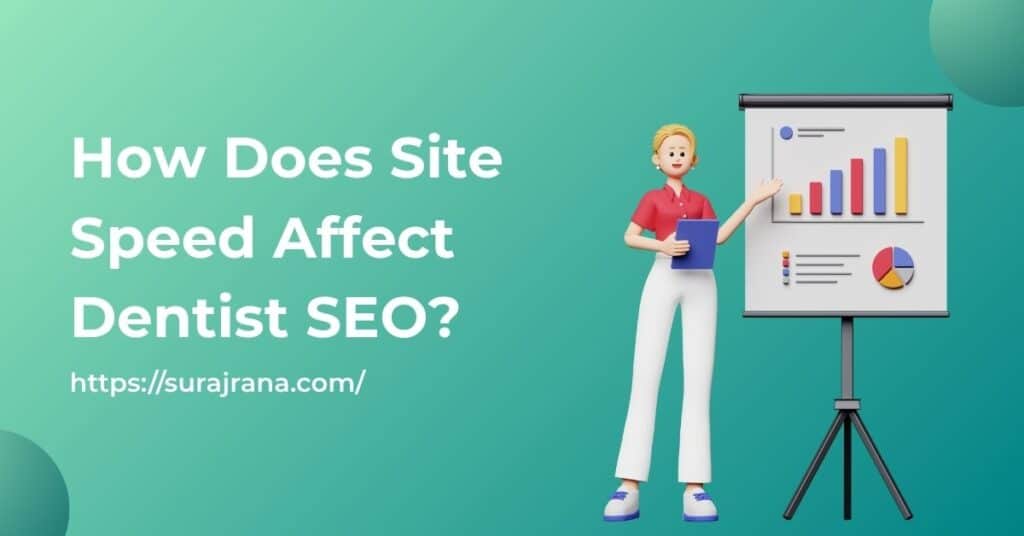Have you ever clicked on a website and waited, and waited,only to close the tab in frustration? Now imagine a potential patient doing that on your dental website.
Site speed is no longer something to overlook,it’s a major factor that can make or break your dental practice’s online success.
A fast, user-friendly site not only helps your clinic appear higher on Google, but also keeps visitors engaged and encourages them to book appointments.
That’s where dental SEO comes in, helping dentists improve their visibility and attract more patients through smart website optimization.
Site speed plays a vital role in how users experience your site and how search engines evaluate it. When your website loads quickly, it creates a positive first impression and boosts user satisfaction.
A slow site, on the other hand, can lead to high bounce rates and lost opportunities. That’s why speed, user experience, and search performance are all connected in the larger picture of dentist SEO.
Why Site Speed Matters for Dentist Websites
Today’s online users have fast-paced expectations. When searching for dental services, people want quick answers, easy navigation, and a seamless experience on both desktop and mobile.
If your website takes too long to load, many visitors won’t wait,they’ll simply leave and go to another dentist’s website.
Studies show that more than half of users abandon a site if it takes longer than three seconds to load.Site speed is closely tied to user experience.
When your pages load quickly, users feel valued and are more likely to explore. A slow or unresponsive website can make people think twice about booking an appointment, even if you’re working with a dental SEO company to improve your rankings.
Since your website often represents your dental practice’s first impression, a slow site sends a negative message about professionalism and reliability,something no clinic can afford in today’s fast-paced digital world.
What Is Page Load Speed?
Page load speed refers to the time it takes for the content of a webpage to fully appear on a user’s screen. This includes images, text, buttons, videos, and interactive elements.
For example, you might have a homepage with before-and-after photos, service descriptions, and an appointment request button.
If it takes more than a few seconds for this content to display, potential patients are likely to leave before they even see what you offer.
Even a one-second delay in page load time can lead to lower user engagement and fewer conversions. That’s why dental websites must monitor and optimize their load times.
A faster website ensures users stay longer and are more likely to take the next step,such as filling out a contact form or booking an appointment.
How Speed Impacts User Behavior
Page speed has a huge impact on how users behave on your site. If your loading time exceeds three to five seconds, many visitors will leave before interacting with any part of your content.
This is known as a “bounce,” and it affects your site’s bounce rate. A high bounce rate signals to search engines that users aren’t finding your site helpful, which can lead to lower rankings.
User trust is also affected by performance. When patients experience delays or errors while trying to access your services online, they may assume your business is outdated or unreliable.
On the other hand, a fast, smooth website builds confidence and creates an impression of professionalism.
This trust can be the difference between someone staying on your site to schedule a visit or leaving to find another provider.
How Site Speed Affects SEO Rankings
Search engines like Google aim to provide the best possible experience for users. That includes recommending websites that are responsive, fast, and helpful. That’s why site speed is now an official ranking factor.
A slow site doesn’t meet those standards and will be ranked lower in search results,even if the content is accurate and useful.This applies to both standard search listings and local SEO rankings for dentists.
For example, if someone searches for a dentist, Google may show a list of clinics at the top of the page. Sites that are slow or score poorly in performance metrics may not appear there, even if they are nearby.
Google uses a set of benchmarks called Core Web Vitals to assess how fast and stable a website is. If your site doesn’t meet the expected standards, it could miss out on valuable visibility and traffic.
Core Web Vitals Explained
Core Web Vitals are specific measurements that Google uses to evaluate the quality of a webpage’s loading speed, interactivity, and visual stability.
The first metric is Largest Contentful Paint (LCP). This measures how long it takes for the main content of a page to load. Ideally, this should happen in less than two and a half seconds.
For example, if your homepage has a large banner image or headline, the LCP time reflects how fast that key section appears.
Next is First Input Delay (FID). This measures the time it takes for a page to respond after a user interacts with it, such as clicking a button.
A good FID score should be under 100 milliseconds.The third metric is Cumulative Layout Shift (CLS). This measures how stable a page is while loading.
If parts of the page move around unexpectedly during loading, users can become frustrated. A low CLS score means elements stay where they should during the load.
For dentists, improving these metrics can boost search rankings and offer a smoother, more user-friendly experience.

Speed and Local Pack Rankings
When users search for local services, Google often shows a “local pack” at the top of the page. This is a listing of three nearby businesses that are relevant to the search.
The websites that appear in this pack often get more clicks and traffic. However, site speed plays a role here too. If your website is slow, it might not meet Google’s standards for local results, even if you’re located near the user.
This is where local SEO services for dentists become important, as they help ensure your website is fast and optimized for local searches.
That means potential patients may not see your clinic in their search results simply because your website didn’t load fast enough or offer a good user experience.
Examples of Slow Site Problems
Imagine a potential patient visiting your website to book a routine cleaning. They click the “Book Appointment” button, but after several seconds, the form still hasn’t been loaded. Frustrated, they leave and choose another dentist instead.
Or consider a parent looking for pediatric dental services. They click on a page featuring information and photos of dental care for children.
However, the page takes too long to load the pictures or descriptions, and the user gives up before seeing anything useful.
Even a returning patient trying to check your operating hours could struggle if your site doesn’t load properly on a mobile device.
These slow load issues can lead to lost appointments, reduced trust, and fewer referrals.
How to Improve Site Speed for Better Dentist SEO
Fortunately, improving site speed doesn’t always require advanced technical skills. There are several simple steps you can take to boost your website’s performance and help with dental SEO success.
One way to improve speed is by compressing images. Dental websites often use high-quality photos of dental work, staff, and facilities.
While these visuals are important, they don’t need to be large files that slow down your pages. Free tools can compress images without reducing the quality.Another key factor is your website hosting.
If your site is on a slow server, it will take longer to load. Switching to a faster hosting provider can make a big difference in performance.Reducing unnecessary plugins, scripts, and redirects also helps.
The more elements your website has to load, the longer it will take. Streamlining your design and removing old or unused features can make your site leaner and faster.Using a content delivery network, or CDN, can also help.
CDNs store copies of your website across different locations, making it faster for users in various regions to access your content.Even reducing your website’s code by removing extra spaces or unused lines can improve load time.
Tools to Test Your Website Speed
Several tools allow you to test your site’s performance and identify areas for improvement. Google PageSpeed Insights is a popular choice. It analyzes your website’s load time and offers suggestions to improve the score.
GTmetrix is another comprehensive tool that not only measures speed but gives detailed breakdowns of what’s slowing your site down. It’s user-friendly and great for beginners.
A third tool, Pingdom, allows you to test how fast your website loads from different parts of the world. These tools help you monitor your progress as you make improvements.
Why Users Trust Faster Sites
Fast websites feel smooth, polished, and reliable. When a page loads instantly, it shows visitors that your practice is well-managed and up-to-date. This builds confidence and encourages them to stay longer, explore your services, or book an appointment.
Investing in essentials like user-friendly design and GMB management for dentists can further enhance that online experience, making your practice appear modern and trustworthy.
A slow website, on the other hand, can make your practice feel outdated or disconnected.
Just like the atmosphere in your physical office matters, the experience on your website reflects your level of care. Make sure that your first online impression is a positive o
Common Mistakes That Slow Down Dental Websites
One common issue is the use of heavy image galleries or background photos that aren’t optimized. While visuals are important, especially on a dental website, they should be adjusted for faster load times.
Outdated themes or plugins also cause speed problems, so it’s essential to make sure your website software is updated regularly. Another mistake is embedding large video files directly onto your web pages.
Videos should be hosted on platforms and embedded using lightweight code instead of being uploaded directly. These simple errors can slow down your entire site and make it harder to retain visitors.
Conclusion
Site speed plays a key role in how well your dentist website performs online. From improving user experience to helping your website rank better in search results, optimizing your site’s loading time is essential to long-term growth and visibility.
If you’re looking to improve performance or need help with site speed and related SEO improvements, reach out to trusted specialists like Suraj Rana SEO who understand how speed impacts results.
By making your website faster, you’ll not only impress visitors but also stay competitive in the search rankings.

My name is Suraj Rana, and I am a seasoned Dental SEO Specialist with extensive experience in the Dental SEO industry. Leveraging my deep knowledge and expertise, I help dental practices enhance their online visibility and attract more patients.


